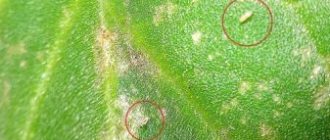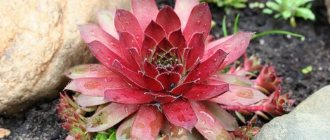Beginners should choose the first violets for their home collection from varieties of domestic breeders , since they were bred to live in the apartments of Russian flower growers.
Of all the variety of Saintpaulias registered by Russian masters, we can recommend the slow but exquisitely beautiful violet YAN-Caprice , which is distinguished by a chic variegated rosette and delicate caps of fringed flowers.
Botanical description of the plant
LE-Malachite Rose is a standard hybrid Saintpaulia or Usambara violet.
The flowers are light pink with an ashen tint, with light green edges. The buds grow up to 4 cm, less often up to 5 cm. The peduncles are long, so the flowers lie on the leaves. The leaf blades are dark green.
With proper care, it blooms profusely for up to 5 months. It is impossible to give an exact date; Saintpaulias bloom almost all year round. In this variety, alternate blooms replace each other without stopping.
TOP 10 most popular varieties
Pink Panther
A luxurious bouquet of delicate, pink-cream flowers. The edges of the petals are corrugated, with a wide white border, in the middle the color is brighter. In the center of the flower the shade is more saturated. The flower is very double and printed. The petals are arranged from the center of the bud in a graceful spiral.
The rosette is compact, smooth, rich green in color.
EK-Goddess of Beauty
A spectacular, very rich variety of fuchsia-colored violet with a slight lilac tint. The petals are wavy, very elegant, festive.
Large flowers can reach 7 cm in diameter. They are very heavy and droop a little and can be laid on the leaves. Many buds open at once - up to ten.
Your Majesty
The even pale raspberry color of a cold, pure shade gives Your Majesty the violet royal sophistication and brilliance. Lush buds look like a ballerina’s tutu, the petals are smooth and very laconic in shape, without unnecessary curls, with a diameter of 5 cm.
The rosette is large, formed neat and even.
Aelita
Lush corrugated inflorescences with delicate watercolor tints on the petals - at the edges the color dissolves in a milky shade, and closer to the middle it approaches crimson or peach.
The Aelita variety is prone to cap flowering. Compact bush with embossed leaves.
LE-Peachy shine
Warm, caramel peach bouquet. The flowers are very large, 6-7 cm. Just one row of lacy petals is decorated with crimson rays radiating from the center of the inflorescence. The bright yellow stamens are well defined and pleasantly highlight the richness of the bud.
Standard size rosette, leaves with long petioles.
Winter smiles
The incredible variety Winter Smiles is unlike others - as if the snow is sparkling in the sun, and there is a lemon or lettuce openwork edge around the edges. The flowers are medium in size - about 5 cm.
Blooms long and profusely. The underside of the leaf is purple.
Fairy (Dadoyan T.L.)
Pale pink violet with star-shaped flowers and small purple markings - dots and stripes. Lace fringed edges, round buds, similar to cotton candy balls.
A fabulous lush bouquet of a dozen flowers is common for this variety. Standard dense rosette of large leaves.
Buckeye Colossal
This violet looks more like an outlandish orchid than a cute bush from grandma's windowsill. Lilac star-shaped flower, semi-double. Scarlet or purple sparkles are scattered along the edges of the wavy leaves. The buds are medium in size, about 5 cm.
SM-Pink pearl
Pearlescent double inflorescences with slight tints on the petals from peach to cool pink. In the center of the petal the shades become brighter. Diameter up to 6 cm.
The socket is standard, smooth, and does not require shaping. The flowers remain fresh for a very long time.
RS-Pink Paradise
A lush cap of delicate, very decorative crimson flowers with fuchsia splashes around the edges. The core of the bud is almost white.
Pointed lettuce leaves emphasize the freshness of the elegant bouquet. The flowers are simple or slightly double, the edges are slightly wavy, but very beautifully molded.
Basic conditions for growing violets at home
Violet lovers will confirm: the microclimate for Saintpaulia is one of the main components of successful flowering. This statement also applies to the Malachite Rose violet. When growing it, consider three factors: lighting, temperature and humidity.
Placement and lighting
Optimal lighting is bright, diffused light. A window sill near a west or east window is ideal. If the light is very bright, you can cover the window with a light cloth or paper.
Daylight hours should be up to 14 hours. To extend it in winter, you can use biolamps.
Did you know? The violet variety Malachite Rose was bred by the famous Ukrainian breeder Elena Lebetskaya in 2012.
Temperature and humidity
Violet needs a temperature of +18…+24°C. It is not advisable to lower it lower. +15°C is already dangerous indicators. Avoid drafts and sudden temperature changes.
Keep humidity at 50-60% or higher. Malachite rose will be damaged by dry air. Direct moistening from a spray bottle is also unacceptable. If the humidity level is below normal, use a humidifier.
Breeder Natalya Puminova
Natalya Aleksandrovna Puminova is a breeder from Moscow, a programmer. She is a very subtle, delicate person, modest. Talented, with good taste. A simple woman with a friendly smile. She began breeding violets in 1996. She began to name her varieties using the prefix “Yan”.
Natalya wanted to see something new and unusual on her shelves, but it was difficult to get the right plants. Selection provided such an opportunity; she managed to create something unique, unlike other flowers in the collection. The first variety released by Natalya was “Blue Gift”.
It is very difficult to impartially select plants grown with your own hands, moreover, if these are crops that have been bred through many crossings. Puminova violets are visible from afar - even rosettes with richly colored flowers.
How to care at home
Measures for caring for the Malachite rose include watering, fertilizing, plant formation and replanting.
Watering
When watering violets, flower growers name three rules that must be strictly adhered to:
- the substrate must be moist, but stagnation of water is unacceptable;
- When watering, do not moisten the leaves, stems and flowers;
- Water for irrigation must be warm.
The frequency of watering depends on the microclimate in the room. It is this that affects the rate of drying of the soil. The method of hydration is also important. Violet growers use different watering methods.
It can be:
- watering along the edge of the pot (2 times a week);
- bottom watering through drainage holes (once every 1.5 weeks);
- wick watering, in which a rope is threaded through holes for drainage and the ends are lowered into water (enough for 2 weeks, ideal for vacation).
Fertilizer application
The flower needs microelements. To grow, it definitely needs nitrogen, potassium and phosphorus. Other elements and vitamins are also needed. For this reason, without fertilizers, the Malachite rose will grow and bloom poorly.
Fertilize the plant during the period of active growth. Feeding is especially needed during flowering. The flower should be fed once every 10–14 days.
Products specifically for Saintpaulia are on sale. These include the mineral preparation Mister Color Saintpaulia.
Important! Fertilizer is prohibited in three cases: a month after transplantation, in case of microclimate disturbance and in case of disease development.
Trimming
To form a bush, leave 3 rows of leaves. The lower leaf plates are pinched off, removing the petioles. Get rid of faded flowers and foliage. Unnecessary parts should be removed as necessary.
Transfer
The plant is transplanted in the spring, preferably in March. The frequency of transplanting a healthy violet is once every 2–3 years. The flower can be moved to a new pot even if the Saintpaulia wilts. Her condition could have been affected by the composition of the soil or illness. In this case, the transplant will save the flower.
Violets grow in loose, breathable soil. Due to the popularity of violet growing, soil for Saintpaulia can be found in any flower shop. You can prepare the substrate yourself.
To do this, mix:
- sheet soil (3 parts);
- turf soil (2 parts);
- peat soil (1 part);
- coniferous soil (1 part);
- vermiculite;
- perlite;
- river sand in large fractions;
- crushed sphagnum.
Also prepare a drainage mixture for replanting.
The pot should be small. You can simply change the substrate and place the violet in the same pot. If the root system has grown greatly, it is better to purchase a new container with a diameter 2 cm larger than the previous one. The transplant process is as follows:
- Fill a third of the pot with drainage mixture.
- Pour the substrate into the container.
- Moisten the flower and carefully remove it from the container (if only the substrate is being changed, perform this step first).
- Place the violet in the new soil.
- Add soil to the top of the pot.
- Water the plant.
Did you know? The natural habitat of Uzambara violets is the mountains of Tanzania and Kenya.
Peculiarities
Jan-Caprice is a very unusual, original variety. Both his flowers and the rosette itself are good. Terry flowers of medium size, with a wonderful openwork ruffle from greenish to bronze with a pink tint. Most often there are three flowers on one peduncle, but sometimes there are 5. The peduncles are strong, erect, and rather short. Thanks to such peduncles, even three flowers form a small openwork bouquet. An adult rosette blooms often, and the flowers last a very long time - up to two months.
The rosette is compact, smooth, self-forming, of beautiful dark green quilted leaves with a white, sometimes slightly pinkish border along the wavy edge of the leaf. The green part of the leaf blade is glossy, and the white wavy edges create a velvety feeling. On young rosettes the variegation is often weakly expressed. As the rosette matures, the light velvety border appears more and more. With sufficient lighting, the leaves slightly “hug” the pot. The blooming rosette is surprisingly harmonious. A beautiful openwork bouquet of creamy-white lush double flowers, “painted” with a greenish-bronze-pink pattern of a ruffled border, merges into a single whole with dark green leaves, trimmed with a soft wavy creamy-white border.
The variety is unpretentious in care. Easily tolerates short periods of dryness that may occur during the owner's departure. But you need to be patient - it grows slowly. Loves natural daylight. In cool conditions, variegation becomes more intense. The variety is quite suitable for beginner violet lovers.
Jan-Caprice, N. Puminova, photo by Svetlana Sazykina (flowering of a young rosette with mild variegation):
Jan-Caprice, N. Puminova, photo by Svetlana Sazykina (adult outlet):
Violet Jan-Caprice, first flowering, photo by T. Lysikova:
How to propagate at home
Violet growers use three methods of plant propagation: cuttings, dividing the bush and seed propagation. Each method is associated with its own subtleties.
Cuttings
Cuttings, or leaf propagation, are the most common method in amateur floriculture.
To do this you need to do the following:
- Pinch off a leaf with a 4 cm petiole from the parent plant.
- Place the cutting in a container of water, such as a glass.
- Wait for the roots to appear.
- Plant the cutting in a pot.
Some gardeners plant the leaf in a pot and wait for it to take root. The container is immediately filled with drainage and soil for Saintpaulias. However, this method has a drawback - the process of root emergence is not visible. So the gardener will not immediately understand whether the cutting has started or can be thrown away.
Dividing the bush
If there are many children on the bush, it can be divided:
- Remove the plant from the container.
- Remove the earth ball.
- Divide the rhizome into rosettes.
- Replant in separate pots.
Even blooming violets can be propagated this way. The main thing is that she is healthy.
Seeds
Seeds are often purchased, but you can get them yourself:
- Using a toothpick, transfer the pollen to the pistil from the stamen.
- After 1–1.5 weeks, the ovary of the capsule will appear.
- In six months the seeds will ripen.
- Remove the dried box and open it.
- Using a needle and tweezers, remove the seeds onto a sheet of paper.
We advise you to learn how to make a rack for violets.
Landing occurs as follows:
- Pour the Saintpaulia substrate into a wide, shallow pot.
- Make small furrows in the soil.
- Mix the seeds with sand and distribute along the furrows.
- Cover the crops with glass.
- Leave the container in the light at a temperature of +22...+25°C.
- Remove the glass regularly and moisten the substrate with a spray bottle.
Plant seedlings 5 mm high with leaves into a new pot. Add some coal to the substrate. The distance between the sprouts is 1.5–2 cm. To replant, you will need a small sharp object - a toothpick or a sharpened match. Now you can wait for the violet bushes to fully grow.
Rules for planting and propagation
Saintpaulias are propagated in three ways: cuttings, peduncles and leaves. Transplantation is carried out in early spring. Propagation through foliage is more effective and many people prefer this method. Healthy seedlings without visible damage, cut from the outlet at an acute angle, are placed in a jar of warm water and placed in a warm place. To soften the water, activated carbon is added to it. When roots up to 1 cm appear, the sprout is transplanted into a pot with prepared soil.
If it is necessary to replant an adult plant, it is removed from the old container carefully, without damaging the root system. Transfer to a new prepared pot along with a lump of earth and add fertile mixture to the rosette level
Difficulties in growing
The main difficulties when growing Malachite rose are diseases and pests. They often appear when the grower violates the rules of care. First of all, check and adjust watering and fertilizing.
Among the fungal diseases in violets are:
- powdery mildew;
- late blight;
- gray rot;
- fusarium;
- rust.
To treat any fungus, use fungicides, for example, Fundazol. If the disease does not go away, remove the plant from the flowerpot and burn it.
The most common parasites on Malachite Rose are:
- mites;
- scale insects;
- false scale insects;
- thrips;
- scale insects;
- aphid;
- woodlice;
- springtails;
- whiteflies.
Parasites are destroyed by insecticides such as Actellik or Aktara.
In this case, you definitely need to reconsider the care of the flower. Important! Prepare all medications exclusively according to the instructions.
LE-Malachite rose is unpretentious, but requires regular care. If grown correctly, this miracle of Ukrainian selection will delight you with lush flowering for many months.
What is the attractiveness of violets Jan-Caprice sport
It often happens when growing violets that the plants bloom in the wrong variety. The color of flowers and leaves is noticeably different from the original. This happens because varietal characteristics are not fully inherited.
These plants are called “sport”. Of course, flower growers are upset about this, but sometimes the sport looks much better than the variety.
So no need to be upset when you get a sport instead of a variety.
Perhaps your pet will surpass the variety and become the ancestor of one of the new varieties. And it also needs to be said that if instead of a variety you have a sport, then there is no way to correct this. All that remains is to decide whether to keep it or throw it away.
You will learn more about the Jan-Caprice violet when watching the video:
https://youtube.com/watch?v=uXQwoeKX55c
LE-Malachite Rose
Discussion of Saintpaulia varieties by breeder Elena Lebetskaya.
Moderator: Floriana
Elena M. Messages: 4544 Registered: Oct 22, 2010, 10:49 pm Awards: 21 From: Moscow
LE-Malachite Rose
#1
Post by Elena M. » March 23, 2013, 00:26
Saintpaulia LE-Malachite Rose (Lebetskaya E.) Ash-pink, large, cup-shaped stars with a wide, green border.
Elena M.
Elena M. Messages: 4544 Registered: Oct 22, 2010, 10:49 pm Awards: 21 From: Moscow
Re: LE-Malachite Rose
#3
Post by Elena M. » Oct 21, 2013, 11:43 pm
I got myself a Malachite Rose again. My first one was a bit pale.
Here she is.
I took a leaf from a brightly colored copy from Lena Lebetskaya’s rosette. It seems like nothing happened... Pink.
Elena M.
red_vale Messages: 416 Registered: Jan 27, 2013, 10:11 pm Awards: 10 From: Russia
Re: LE-Malachite Rose
#4
Post by red_vale » 22 Oct 2013, 16:18
The flowers of this variety are very beautiful, but the rosette seems to be difficult, mine is already spinning in children. Does she need a lot of light? Where is the best place to keep it?
red_vale
Elena M. Messages: 4544 Registered: Oct 22, 2010, 10:49 pm Awards: 21 From: Moscow
Re: LE-Malachite Rose
#5
Message Elena M. » 22 Oct 2013, 16:27
She has a rosette, like the Bronze Horseman, but it seems a little smaller. These varieties have a somewhat harsh rosette, the leaves “twist” a little, but it is absolutely tolerable. And when there are a lot of leaves, then the overall appearance is decent and even neat. A medium amount of light is needed.
Elena M.
Svetlana_P Messages: 56 Registered: Dec 10, 2010, 4:37 pm Awards: 5
Re: LE-Malachite Rose
#6
Post by Svetlana_P » Dec 23, 2013, 12:08 pm
Elena M., which variety did you like best? LE - Malachite Rose or Bronze Horseman? And if possible, then write with what, what characteristics? Thank you.
Svetlana_P
MarishaT Messages: 76 Registered: 16 Nov 2012, 14:02 Awards: 7 From: Vladikavkaz
MarishaT
Elena M. Messages: 4544 Registered: Oct 22, 2010, 10:49 pm Awards: 21 From: Moscow
Re: LE-Malachite Rose
#9
Post by Elena M. » December 25, 2013, 10:12 pm
Svetlana_P, I keep both the Malachite Rose and the Bronze Horseman. The Horseman has greener flowers. Rose's pink is more intense. The rider is fatter and larger. The rose is more graceful if this applies to the stiff rosettes that like to twist the leaves (both varieties).
MarishaT – nice pink color on your Malachite Rose!
When this variety has weakly colored flowers, it looks less impressive.
Elena M.
MarishaT Messages: 76 Registered: 16 Nov 2012, 14:02 Awards: 7 From: Vladikavkaz
Re: LE-Malachite Rose
#11
Post by MarishaT » December 27, 2013, 08:56
“In what land does it grow in you? And what do you feed?” We grow in Klassman peat with the addition of perlite and “eat” Fertika. The first flowering began in September, in fairly cool conditions on a northern window sill, illuminated by one lamp. Could the temperature of the content affect the color of the flowers? The socket is a bit harsh, which upsets me a little.
MarishaT
Elena M. Messages: 4544 Registered: Oct 22, 2010, 10:49 pm Awards: 21 From: Moscow
Re: LE-Malachite Rose
#12
Message Elena M. » 23 Jan 2015, 21:49
I decided to part with the variety. Indeed - a difficult socket.
Now a new variety LE-Mistress of the Copper Mountain has appeared. The flowers are similar, but more waxy and more interesting, and the rosette is different. Compact, more flexible.
Farewell photo of Malachite Rose.
Elena M.
Nadinka Posts: 11 Registered: 06 Oct 2022, 23:30 From: Ternopil
Nadinka
Nadinka Posts: 11 Registered: 06 Oct 2022, 23:30 From: Ternopil
LE-Malachite Rose
#16
Post by Nadinka » 09 Oct 2022, 00:00
I noticed that in summer violets always bloom brighter and darker (+25 - +30 in the apartment), and in winter (+19 - +21) they are paler, and in two-color violets a white or light shade dominates.
I have the Malachite Rose with a pink tint, and the Mistress of the Copper Mountain is pale, but they are very similar and I can’t decide which variety to keep
Nadinka
Classification
All varieties of double violets can be divided into groups according to several criteria. For example, depending on the brand of sponge, two main groups can be distinguished:
- Sponge;
- Semi-double.
The photo shows a purple sponge. In addition, there is a division into groups depending on the appearance of the Saintpaulia inflorescence:
- Combed;
- Carnation.
Colors stand out:
- Light terry violets;
- A type of dark sponge.
IMPORTANT! Violets of different colors conventionally form separate groups of Gesneriaceae sponges. The first includes red, pink and raspberry Saintpaulias. The second consists of blue, blue and gray flowering plants.
Among the brightest representatives of the sponge, in particular, there are varieties:
- Atlantis;
- Bridal bouquet;
- Lyubasha;
- And a few more.
Dark Saintpaulias are adequately represented by Chateau Brion and Gift for a loved one.
Most often, on the windowsills of avid gardeners you can see Saintpaulias with a simple variety of sponge. These plants differ from all other species:
- Leaf shape (round and soft leaves of dark green color);
- As well as the structure of the flower of the plant.
In representatives of the genus with a simple type of duality, the corolla consists of 4-6 petals.
Flowers with the so-called bivalve comb degree usually have at least 6 petals in the corolla. Most often, the number of petals of such a plant can be at least 8-9 pieces.
One of the most famous varieties of scallops is a gift for a loved one. It also differs from other terry varieties in the shape of its petals. The fact is that in plants with this type of sponge, the upper part of the inflorescence has a wavy shape with a fringe above the flower.
Semi-double flowers are recognized:
- The shape and color of the leaves (round or oval, velvety, light green);
- And also by the number of petals in a flower rosette (from 6 to 9).
In turn, terry Saintpaulias have 10 or more petals in a rosette of flowers.
As for such a double variety as carnation, such varieties have an incompletely opened rosette with semi-double petals.
ATTENTION! The shape of the flowers of such violets resembles carnation flowers, hence their name.
Reviews
Tatiana Lysikova. I would refrain from saying that the variety is light and simple. The first rosette of this variety lived with me for almost 2 years; I saw 3 flowers once. Last year I bought a cutting from a different line. The cuttings sat for a long time, then babies appeared and grew quite slowly. The first flower stalk appeared 10 months after planting the cutting. Now the rosette is blooming and new flower stalks are appearing. I grow on a wick under LEDs. My flowers don't last for 2 months. Each flower stays in good condition for 3-4 weeks, then it begins to darken, but new flower stalks appear to replace the fading flowers. I like the variety and finally I got what I wanted.
Violet Jan Caprice is a very beautiful, but at the same time slow variety. Unusual, lush, curly flowers with fancy colors may appear on the rosette only in the third or even fourth year. Therefore, after reading the photo and description of the variety, some gardeners are disappointed in it, thinking that they failed to grow their specimen.











